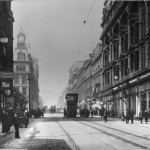 Sauchiehall Street is a name unique to Glasgow and yet known well beyond the city limits. It’s a long street by Glasgow standards and was renowned for its department stores, hotels, cinemas, restaurants and tearooms as well as art galleries and a range of smaller businesses. Much of the street is situated on a hillside that was probably once moorland, parts of which may have been wooded and others later cultivated. The sauchie haugh or willow meadow from which the street derives its name was probably a low-lying area located near what would later become Charing Cross. The development of Sauchiehall Street was part of the westward growth of the city, spurred by the desire of wealthy merchants to own property on the outskirts. Villas and terraces with distinguished names like Kensington and Windsor Place were constructed during the second decade of the 19th Century and the street became a quiet and narrow suburban thoroughfare known as Saughie-haugh Road. It was widened in 1846 and then in the 1850’s some of the older buildings were replaced with tenements and in the 1870’s with commercial properties. The 1896 Ordnance Survey map of Central Glasgow still shows some villas remaining on the north side of Sauchiehall Street in the section between Thistle Street and Scott Street.
Sauchiehall Street is a name unique to Glasgow and yet known well beyond the city limits. It’s a long street by Glasgow standards and was renowned for its department stores, hotels, cinemas, restaurants and tearooms as well as art galleries and a range of smaller businesses. Much of the street is situated on a hillside that was probably once moorland, parts of which may have been wooded and others later cultivated. The sauchie haugh or willow meadow from which the street derives its name was probably a low-lying area located near what would later become Charing Cross. The development of Sauchiehall Street was part of the westward growth of the city, spurred by the desire of wealthy merchants to own property on the outskirts. Villas and terraces with distinguished names like Kensington and Windsor Place were constructed during the second decade of the 19th Century and the street became a quiet and narrow suburban thoroughfare known as Saughie-haugh Road. It was widened in 1846 and then in the 1850’s some of the older buildings were replaced with tenements and in the 1870’s with commercial properties. The 1896 Ordnance Survey map of Central Glasgow still shows some villas remaining on the north side of Sauchiehall Street in the section between Thistle Street and Scott Street.
This shows the view looking west along Sauchiehall Street from the eastern end, at the intersection with Buchanan Street where the tram lines curve in from Parliamentary Road. Armstrong’s Hotel is on the left and on the right with its magnificent tower and Grecian temple front is St. John’s Methodist Church. The tower was taken down in 1957-58 to make way for St. Andrew’s House, a multi-storey office building, but the church itself remained in use until 1974.
On the left, beyond the intersection with West Nile Street, is the Baroque Empire Theatre which opened in 1897. It attracted some big name performers and particularly in the years after the Second World War when American stars including Bob Hope, Frank Sinatra, Judy Garland, Dorothy Lamour, Jack Benny and Danny Kaye played to packed houses.
Perhaps a good way to start our journey down the Sauchiehall Street of yesteryear is with breakfast at Armstrong’s Hotel at the far eastern end of the street. Their dining room affords a fine view westward along the first part of Sauchiehall Street as it rises steadily uphill into the distance. And we have a good view of the magnificent tower and temple frontage of St. John’s Methodist Church on the right.
The Empire Theatre, 35 Sauchiehall Street
Looking from the Empire Theatre diagonally across the intersection with Renfield Street was the Central Halls Building, a complex of offices, shops and a hall, designed by the architect James Thomson. The Royalty theatre opened there in 1879 and became famous for comedies, opera and plays. It served as the Glasgow base of the D’Oyly Carte Opera but when Howard & Wyndham’s lease ran out in 1913, the Central Halls Company who owned the property ran the theatre as the Lyric Picture Palace. During the First World War, the building was purchased by the YMCA and it became their Hostel for Soldiers and Sailors. After the war, the YMCA reopened the theatre as the Lyric Theatre. This picture shows the building when it was owned by the YMCA and it remained so until it was demolished in the late 1950’s. ( Publisher not known. )
This mid-1920’s view of Sauchiehall Street looking west was taken near the Renfield Street intersection. In the foreground is the entrance to the Lyric Theatre located in the YMCA building and there are businesses all along the frontage, including a branch of A. Harris, the tobacconist, and a service offering hair cutting, shaving, chiropody and manicure. Part of Renfield Street United Free Church is visible on the left, beyond the intersection, and a branch of R.S. McColl, the confectioner, has good exposure on the corner. ( Postcard published by Judges Ltd., Hastings )
This Valentine’s photo was taken at the same location in 1932 and the ornate street lights have now been replaced by more utilitarian ones with a longer reach, providing better illumination over the roadway. The policeman on point duty has stopped traffic so that the tramcar can turn right into Sauchiehall Street from Renfield Street. Three years earlier, the name of the church had been changed to Renfield Street Church of Scotland and it continued as such until it closed in 1964 when the congregation became part of what it now known as Renfield St. Stephen’s Church in Bath Street. ( Postcard published by Valentine’s of Dundee. )
A tramcar heading for the International Exhibition at Kelvingrove Park is just turning into Sauchiehall Street from Renfield Street in this 1901 scene. The city where the Industrial Revolution began was hosting its second great International Exhibition and the recent electrification of the tramway system served to further showcase Glasgow’s achievements. The cars were resplendent in their colourful livery of cadmium orange side panels, ivory trim and plum/brown for the dashes. Each route was colour-coded and car 664 in the foreground would have had chrome yellow panels above the windows, bearing route information, probably similar to that of the car in the background.
A young girl is focussed on the photographer in this view looking east along Sauchiehall Street towards Armstrong’s Hotel and Parliamentary Road in the distance. The Central Halls Building, housing the Royalty Theatre, is on the left of the picture and the magnificent tower of St. John’s Methodist Church can be seen further along the street. A crowded, former horse-drawn tramcar bound for Botanic Gardens is coming round the corner from Renfield Street while a smartly dressed man waits beside the kerb. Everyone wore a hat in those days and there is quite a collection on display.
This scene from an undivided back postcard is looking west along Sauchiehall Street from the Renfield Street intersection soon after the tramway had been electrified in 1901. The premises on the right are not yet occupied by Lumley’s and the adjacent building with the newsagent would be completely rebuilt and refitted as the Salon Cinema by June 1913. The Crown Halls next door were occupied by a firm of auctioneers and valuators. ( Publisher not known. )
In this view looking west across the intersection with Renfield Street, part of Renfield Street United Free Church is visible on the left and, on the opposite corner, Lauder’s Bar is on the ground floor of the building and Lumley’s the sports retailer now occupies the other three floors. The curious light-coloured building next door is the Salon Cinema which opened in June 1913. It was designed in the Moorish style by Thomas Baird and the facade was finished in square tiles set in a diagonal pattern. Patrons would enter through a large doorway framed by two pillars each side and topped with a grand arch containing three windows. Unfortunately, the business was not a success and it closed in May 1923, whereupon another major renovation began. The facade was replaced with a more contemporary one and three new floors were built within the space formerly occupied by the auditorium. When it was completed, Lumley’s moved into the premises. ( A “Pelham” Series Local View published by Boots the Chemist. )
This view of the same location taken after 1923 shows the completed Lumley House and Bruce’s Furniture Galleries now occupy the space vacated by Lumley’s on the corner. On the other side of Lumley’s are the Crown Halls. There is still a policeman on point duty as this was well before traffic lights were introduced. The tramcar approaching the intersection is bound for Clarkston. It had a long way to go. ( Postcard published by J. & M. Caledonia Series. )
In this scene, dating from around 1910, we have now crossed Renfield Street and are walking up the south side of Sauchiehall Street towards the intersection with Hope Street. We have passed the Crown Sale Halls on the opposite side of the street and are now looking across to the Globe Restaurant at number 110 and the Osborne Hotel, a temperance hotel listed in Baedeker’s 1906 handbook. The name Osborne had become popular during Queen Victoria’s reign as it was the name of her favorite home with Prince Albert on the Isle of Wight. The Glasgow hotel of this name would later become the Royal Hotel and, unlike the Osborne, it was not a temperance establishment. Until the Scottish licensing laws were changed in 1976 only hotels and restaurants could serve alcohol on Sundays and the Royal along with many others did a brisk trade. ( Postcard published by M. Wane & Co. Edinbro’. )
We have now moved up to the Hope Street intersection in this printed view which dates from the late 19th Century. Gas lamps still illuminate the streets and the trams are horse-drawn. The property housing Craske’s cloaks is the only two storey building fronting the south side of the street in the entire block. Cloaks are now out of favour but the term cloakroom still survives. Across the street from Craske’s is P. & P. Campbell of the Perth Dye Works, who operated a chain of cleaners and dyers. The driver of the horse-drawn cart making its way up the street is adhering to the path of the tramlines in order to reduce the bone shaking from riding on the cobblestones. ( Publisher not known. )
We have turned to look back, eastward across the intersection with Hope Street where traffic lights have now been installed in this late 1930’s scene. The Royal Hotel, formerly the Osborne, is on the left and beyond that are the Crown Sale Halls and Lumley House. In the distance is the YMCA and the magnificent tower and cupola of St. John’s Methodist Church. The bus pulling away from the kerb is unusual in that it has three axles and was an AEC Renown, the only one that was in service with Glasgow Corporation. In the distance, the street bares left into Parliamentary Road where the sun is shining on the tenement building. ( Postcard published not known. )
This view of Sauchiehall Street looking west across the intersection with Hope Street was taken soon after the tramway system had been electrified in 1901 and new, decorative electric street lights had replaced the gas lamps. Transport is powered by man, horse and electricity in this scene and it must have been hard work pulling a cart up Sauchiehall Street. A sign outside one of the shops on the left proclaims New Etchings by D. Y. Cameron, the celebrated artist and member of the Glasgow School, whose works were much sought after and who was later knighted by King George V. Across the street, P. & P. Campbell, the cleaners and dyers, are offering a special on carpets. The clock tower in the distance marks Copeland and Lye’s department store, usually referred to as Copeland’s, and beyond that is the dome of Pettigrew and Stephens.
In this unusual view of Sauchiehall Street, taken around 1920, the camera is looking down from a first storey rooftop on the south side of the street, near the intersection with Hope Street. The building with the light façade and bay windows across Sauchiehall Street is occupied by M. Bryce & Son, upholsterers, cabinet makers and carpet warehousemen. In the imposing building next door, considered by some to be the most handsome on the street, the Picture House is showing silent films. Years later, it would become the Gaumont. The dome in the distance is the cupola on the Treron building at the corner with Rose Street. ( Caledonia Series postcard published by J. M. & Co., Ltd. )
We are now back to street level and the date is around 1905. On the far right is the awning for M. Bryce, the cabinetmaker. We can now take a much closer look at the fine red sandstone building next door, designed by the brothers Hugh and David Barclay and completed in 1893 for Messrs. Cumming and Smith who had built up a successful carpeting and furniture business in Townhead. Surprisingly, after spending only 10 years on Sauchiehall Street, Cumming and Smith decided to move back to their old premises and now several small businesses line the front of the building. The Picture House would not open until 1910. Further up the street, at number 158, is the Rodmure School of Dress which would soon relocate to premises above Reid & Todd at the corner with Cambridge Street. On the south side of the street, the vertical development of the single storied block between Hope Street and Wellington Street has now begun with the completion of a multi-storey warehouse with space to let. The businesses in the adjoining premises are many and varied, including Stobo, the tobacconist, S. Langfier, the photographer and the Scottish Bible and Book Society, together with an importer, and an enterprise offering electrolysis. The ornate standards by the kerb are not bearing street lights but instead support the tram wires. When the system was electrified, there were no buildings on this side of the street tall enough to support the wiring. The tramcar in view, heading for Langside, is an early example of one with an enclosed upper deck. ( Photograph by T. R. Annan. )
We have now moved forward nearly thirty years and the south side of Sauchiehall Street between Hope Street and Wellington Street has changed completely. Craske’s Cloaks and the single storey buildings present at the turn of the century have now been swept away and replaced by more substantial properties. The left corner is now occupied by Watt Brothers, the ladies outfitters, which is still in business today having extended its premises and diversified its retail inventory. Next door at 123 Sauchiehall Street is one of James Craig’s tearooms whose excellent teas were complimented by their first class baking. The tearoom was rebuilt in lavish style and relaunched by James Craig as The Ruhl in 1927. Also occupying the same building is a branch of Birrell’s, the confectioner, and rival to R.S. McColl. At the time this photograph was taken, the very elegant, curved and embellished lampposts which had borne Glasgow’s first electric streetlights for over thirty years were being replaced with taller, more utilitarian versions which had a longer reach and would provide better illumination of the roadways. The great increase in motorized traffic had necessitated improvements in lighting. The sandwich board man is advertising a list of railway lost property items for sale, including furs.
Here is the scene in the 1950’s and traffic lights have now replaced the policeman on point duty. Traffic lights first appeared in Glasgow in 1937 and their introduction generated a lot of coverage in the newspapers. James Craig’s Ruhl, noted for its tea and cakes as well as Scottish paintings, would continue until 1957. The cinema known as the Picture House has now become the Gaumont. Glasgow people loved “going to the pictures” and the city was at one time home to over 130 cinemas, accommodating a total of 175,000 persons, over 10% of the total population. The cinema provided a great escape from hard work in the yards and factories and from loads of washing and ironing at home. ( Publisher not known. )
Continuing our walk along Sauchiehall Street we are now approximately halfway between Hope Street and Wellington Street and are about to pass the Picture House on the right with its cafe. This cinema opened in 1910 and would later become the Gaumont. A little further up on the left is the La Scala cinema which claimed to be more upmarket and offered “High Tea” while you were watching the film. The building with the clock tower which we are approaching on the left houses the Copeland & Lye department store.
We are now approaching the junction of Wellington Street with Sauchiehall Street and the rather fine French-styled building on the corner, known as Caledonian House, was occupied by Copeland & Lye Ltd., the department store. William Copeland and John Lye had founded the business in 1873 in Cowcaddens and five years later they moved to Sauchiehall Street. In 1901, the store was expanded to include premises at the Bath Street corner. Copeland’s specialized in drapery, clothing and dressmaking and was very popular with the ladies, even more so after they added a restaurant and tearoom. It was one of several large stores in the city to use a pneumatic cash transfer system which was fascinating to watch in operation. The sales person would write up your purchase and then enclose the details together with your payment in a cylindrical canister which was then loaded into a tube and conveyed at high speed on a cushion of air to the cashier’s office. After a brief delay, the canister would be returned to the sales counter in another tube, complete with the receipt and any change.
On the right of this photograph is the Sauchiehall Street branch of Woolworth’s, easily recognizable from the signature gold lettering on a rich red background. Frank Winfield Woolworth founded the company in the United States in 1878 as a “five and dime” store and it became an international success. Woolworth’s sold a range of household items, clothing, toys and confectionery, and was very popular with the people.
The Restaurant de Luxe
An advertisement in the Glasgow Herald of 22nd April, 1909 announced that Copeland & Lye’s new Restaurant de Luxe was now open to the public, and offered the following;
Dainty Luncheons. Light Refreshments. Afternoon Teas. First-Class Cuisine. Prompt and Refined Service. Moderate Charges. Ladies’ and Gentlemen’s Writing and Resting Rooms.
Music by the Caledonian House Orchestra from 1 till 5.
Stuart Cranston’s Waverley Temperance Hotel and Glasgow’s newly electrified tramway system are both featured in this 1901 Sauchiehall Street scene just before the intersection with Cambridge Street and West Campbell Street. A line of trams is coming up the hill and most are probably bound for the International Exhibition held at Kelvingrove Park from 2nd May to 4th November. ( Image scanned from a lantern slide in the collection. )
We have now reached the intersection with West Campbell Street off to the left and Cambridge Street to the right in this late 1920’s scene. Daly’s dress shop is in front of us on the left, and across the street, in the building which used to house the Balmoral Hotel, is the Ministry of Labour’s Employment Exchange. The fine domed structure further up on the right-hand side is part of the Treron et Cie building on the corner with Rose Street.
We are now looking back from whence we came and Cambridge Street is now on the left and West Campbell Street is on the right. The scene dates from around 1900 and the electric trams had only just been introduced. The two rather plain, four-story buildings on the left would soon be replaced with the fine Reid & Todd building shown below.
In this scene dating from around 1910, we are looking east along Sauchiehall Street past the intersection with Cambridge Street on the left and West Campbell Street on the right. The building with the large windows on the West Campbell Street corner is the location for Pettigrew & Stephens Manchester House, the famous department store, and on the other side of Sauchiehall Street is Reid & Todd’s, renowned for selling canes, umbrellas and fine leather goods, particularly for use in travelling. These two buildings, both completed at the turn of the century, display dramatic differences in architectural style. The Reid & Todd building, designed by James Thomson, appears much more conservative and is remarkable for its detailed stonework, especially around the roofline and dormer windows ( not visible in this photograph ). In dramatic contrast, the Pettigrew & Stephens building designed by John Honeyman & John Keppie and with a cupola by Charles Rennie Mackintosh represents a dramatic break with style and dedicates much more wall space to windows. The rounded corner at West Campbell Street emphases its modernity. It must have been so much brighter inside Pettigrew’s compared to other large stores. Above Reid & Todd’s is the Rodmure School of Dress which had recently relocated there. ( Postcard published by W. R. & S. Reliable Series. Printed in Saxony. )
It is now 1923 and the scene here is essentially the same with Reid & Todd and Pettigrew & Stephens facing each other across Sauchiehall Street. The sign on the corner of Reid & Todd’s reads J. Karter & Co. Wholesale Furrier and on the floor above are the offices of the Scottish Society for the Prevention of Vivisection. One can only wonder how the two got along. ( Postcard published by Valentine’s. )
It’s just after 3.25 on a sunny afternoon and the awnings are out at Reid & Todd’s and at Pettigrew’s. A few years have elapsed since the previous photo was taken. The anti-vivisectionists above J. Karter & Co. have moved out and the premises are now occupied by the staff of Berlitz Languages. Daly’s window displays in the foreground are attracting considerable interest. The store that was known as the “Harrod’s of the North” had a reputation for excellence in ladies clothing. Fashions have changed considerably since the Edwardian era and in this scene, raised hemlines and close fitting hats are much in evidence. The white colour-coded tramcar approaching the camera is bound for the University. ( National Series postcard published by Miller & Lang. )
This excellent photograph, dating from 1910-1912 and originally published by E. A. Schwerdtfeger, is taken from the north side of the street looking east and affords a good view of Manchester House, the Pettigrew & Stephens building on the corner with West Campbell Street. The fine cupola, designed by Charles Rennie Mackintosh, is in the centre of the building facing Sauchiehall Street, across from which we have a partial view of the building housing Reid & Todd which is contemporary with Manchester House but much more conservative in design. Nearer the camera on the south side of the street is Daly’s dress shop and the white building after Ramsay & Ramsay is the location for Kate Cranston’s Lunch & Tea Rooms. These were the famous Willow Tea Rooms, originally opened in October 1903 and recently restored. Charles Rennie Mackintosh and his wife Margaret designed virtually every aspect of the interior: the décor, furnishings, cutlery, menus and staff uniforms. In 1917, Kate Cranston sold her businesses and the tearooms remained open under a different name until they became a part of Daly’s in 1928. The sandwich board man outside is advertising Sylvia, the scientific palmist, at an address on Mains Street which would later become Blythswood Street. ( Postcard published originally by E. A. Schwerdtfeger and subsequently republished anonymously after the outbreak of the Great War. )
This photograph is taken slightly further west of the previous one and while not of the same clarity, it depicts a very important event. The date is 8th October, 1915, and a demonstration is taking place in support of the Glasgow Rent Strike. There are rows of quite well-dressed women, four deep, sometimes with a man on the outside, processing westward along the south side of Sauchiehall Street, perhaps heading towards Kelvingrove Park. Further back, a large crowd is following them, carrying placards and passing by Copeland & Lye and Pettigrew & Stephens stores. The Rent Strike was brought about by the attempts of landlords to raise rents at a time of economic crisis during of the war. Munitions factories and shipyards needed more workers and so the demand for rental housing increased. Landlords took advantage of this and when people could not pay the increased rents they were forced out onto the streets. There was a public outcry and a rent strike that began in Govan rapidly spread to Partick and other areas involved with the war effort. Because so many men were away fighting for their country, women played a prominent role in the strike. Demonstrations were organized and when landlords attempted to evict tenants, crowds would block the closes and drive off the Sheriff’s officers and landlords factors. The Government, led by Lloyd George, became so concerned about the threat to war production on Clydeside that it passed the Rent Restriction Act, fixing rents at pre-war levels for the duration of the war and forbidding landlords from raising them.
The large mobile hoarding on the far right is advertising the final week of Rob Roy at the Savoy Theatre, starring John Clyde and Durward Lely in the leading roles. A film version featuring the same two performers had been made in 1911. John Clyde was primarily an actor and Durward Lely had trained as an opera singer in Italy and was a noted tenor.
We have now crossed over to the south side of Sauchiehall Street and are looking across to Brinkley & Son, Miniature Printers, and the Balmoral Hotel, located on the corner with Cambridge Street. An early motorized delivery van is parked outside Muirhead & Turnbull, the piano and organ supplier immediately beside the hotel. Beyond the intersection is the building housing Reid & Todd and the Rodmure School of Dress. In the foreground, the larger stores have given way to small businesses including Miss Boyle and Mrs. Brown both of whom are selling corsets which were becoming more popular as girth increased with prosperity. ( Postcard published by Judges Ltd., Hastings. )
In this 1932 view, we have come further west and are now looking back. We have passed the intersection with Rose Street shown on the left and Blythswood Street, which used to be called Mains Street, on the right and are now standing outside the entrance to the McLellan Galleries in the Treron building. Built in 1856, the Galleries were named after their founder Archibald McLellan who was a coach builder, city councillor and patron of the arts. It was here that the Glasgow School of Art was housed from 1869 to 1899 until it moved to the new, purpose-built premises designed by Charles Rennie Mackintosh on Renfrew Street, just north of Sauchiehall Street. During this time of transition, the group of modern artists known as the Glasgow Boys, renowned for their pursuit of naturalism and realism, were particularly active. Sharing the building with the McLellan Galleries was the department store of Treron et Cie which was not French but wanted to give the impression of being so and was renowned for fashion and fine quality goods. ( Postcard published by Valentine’s. )
This 1924 photograph, taken just west of Dalhousie Street ( left ) and Douglas Street ( right ), shows the full size and scope of the Treron et Cie building which also housed the McLellan Galleries and the Royal Glasgow Institute of the Fine Arts. The latter, founded in 1861, thrives to this day and is in the forefront of promoting contemporary Scottish art. Posters in the windows of Treron’s advertise their July sale and the McLellan Galleries are hosting an Exhibition for the World’s Sunday School Convention. It was a busy time. Very ornate and unique lamp standards are fronting the Treron building and two fine cupolas are in view, one at the Rose Street corner of the Treron building and the other at the West Campbell Street corner of Pettigrew & Stephens. The architectural dome is probably the most graceful feature of classical architecture and here we see two of them in close proximity on Sauchiehall Street. The white tramcar approaching the camera is headed for Woodlands Road and the University at Gilmorehill. ( Publisher unknown but this postcard may be a successor to the pre-war E. A. Schwerdtfeger series. )
It is the early 1930’s and we are looking east along Sauchiehall Street from the corner with Elmbank Street. If the clock is right, the shops and offices have closed for the day and people are heading home. A crowd has gathered outside Lyon’s, the Society Stationer, to view the large selection of postcards and prints on display. In true entrepreneurial spirit, the shop is offering to print visiting cards for tourists while they wait. Obviously having a printing press on the premises gives them a distinct advantage over most stationers. The fine red sandstone building across the road, extending eastward from the Thistle Street ( now Garnet Street ) corner, is known as Ashfield House and was designed by T. L Watson and Henry Mitchell. It was completed in 1903 and incorporates both tenements and shops. ( Caledonia Series postcard published by J. M. & Co., Ltd. )
The full extent of Lyon’s retail premises on the corner with Elmbank Street can be appreciated in this picture, taken during the Edwardian period, when the business was at its height. Founded by William Lyon when he was only 23 years old, the company prospered and by 1885, there was the shop at 385 Sauchiehall Street, a printing works at number 474 Sauchiehall Street and a retail branch in the Argyll Arcade. This particular postcard is dated 20 October 1908 and was used to respond to a customer inquiry. A full account of the history of the company by family member Peter Andrew Lyon may be found at http://www.livinghistory.co.uk/homepages/Lyon/ ( Postcard published by Lyon Ltd., Glasgow. )
We are standing on the south side of Sauchiehall Street between Newton Street and Elmbank Street in this late 1940’s view. The large building with the white façade on the other side of the street is the Beresford Hotel which opened in 1938 in time to provide accommodation for visitors attending the Empire Exhibition. Often referred to as Glasgow’s first skyscraper, the building was designed by William Beresford Inglis who was also the owner and managing director. It is one of the city’s most notable examples of Streamline Moderne architecture, a design style which appeared during the latter part of the Art Deco period. The hotel was a favorite with American servicemen during the Second World War and later became Baird Hall of Residence for University of Strathclyde students. It has now been converted into private apartments. ( Postcard published by Miller & Lang in their National Series. )
We are now very close to Charing Cross in this view taken early in the 20th Century, after the tramway had been electrified in 1901 and before the last tree on this part of Sauchiehall Street was removed in 1906. On the left are the Albany Chambers, designed by Sir J. J. Burnett and completed in 1896. The entrance is flanked by Gavin Crawford & Sons and Hugh Dunlop & Sons with the former having their end of season sale. The sober storefronts of the period do not detract from the fine architecture. Long dark dresses and wide-brimmed hats are much in evidence in this Edwardian scene. ( Rotary Photographic Series postcard )
In this scene, taken from the pavement outside the Grand Hotel and looking east up Sauchiehall Street, the tramcars are still the dominant mode of transport but motor cars are becoming more evident and there is also Leyland Titan Corporation bus, the first of which entered service on Glasgow streets in February 1928. The entrance to the Grand Hotel is just visible on the left, flanked by pillars, and Harris the tobacconist, R. S. McColl and the Royal Bank occupy premises along the front. Hemlines are going up, as illustrated by the two ladies chatting beside one of the hotel lamp standards.
This view, looking East along Sauchiehall Street, was taken from an upper room in the Grand Hotel. On the left are the Charing Cross Mansions, superbly designed by J. J. Burnet for Burnet, Son & Campbell and built in red sandstone in 1889-91. Newton Street opens on the right and William Skinner’s tea rooms are on the ground floor at the corner facing the camera. William Skinner & Son was one of the oldest established tea room enterprises in Glasgow, having been founded in 1835. The business started out further up Sauchiehall Street and in due course established a reputation for teas and luncheon. The premises were furnished in the French style and cultivated an atmosphere of conservative elegance. ( There is some discussion of William Skinner & Son’s enterprise in the comments section. ) On close examination, the Standard tram cars in view are fully enclosed and still have the color-coded upper panels so this view probably dates from the mid to late 1930’s. ( Postcard published by Photochrom Co. Ltd., Royal Tunbridge Wells.)
Legends © Christopher J. Jones
Except where otherwise stated, all photographs are from the author’s collection.
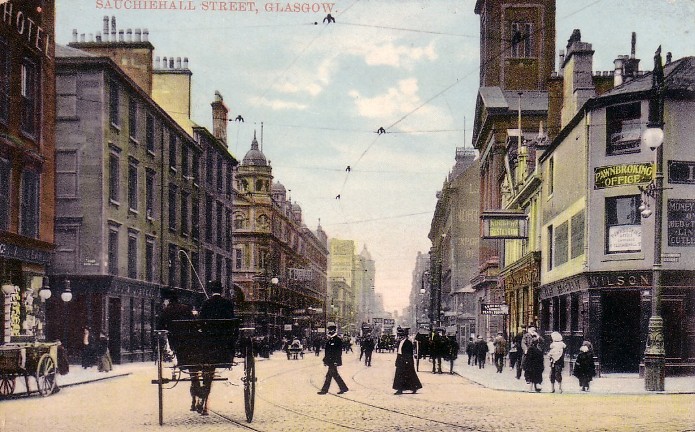
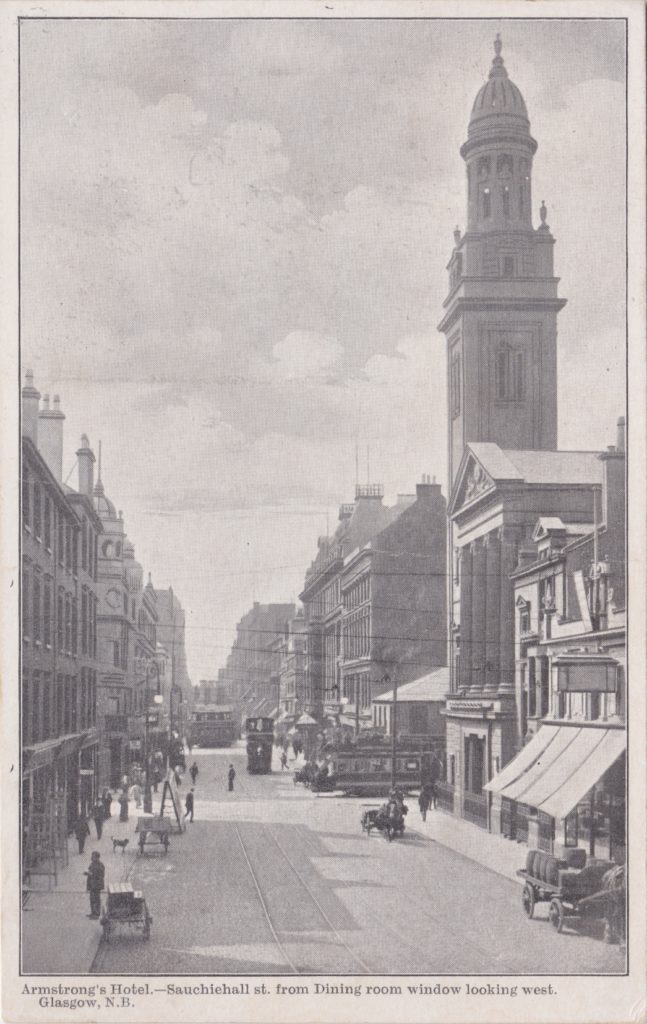
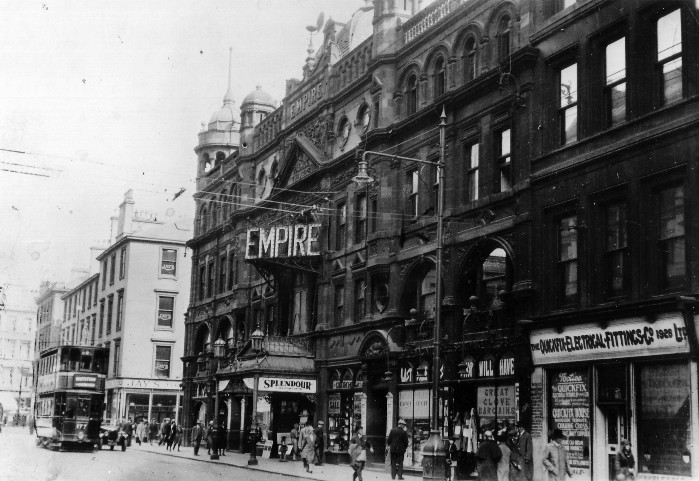
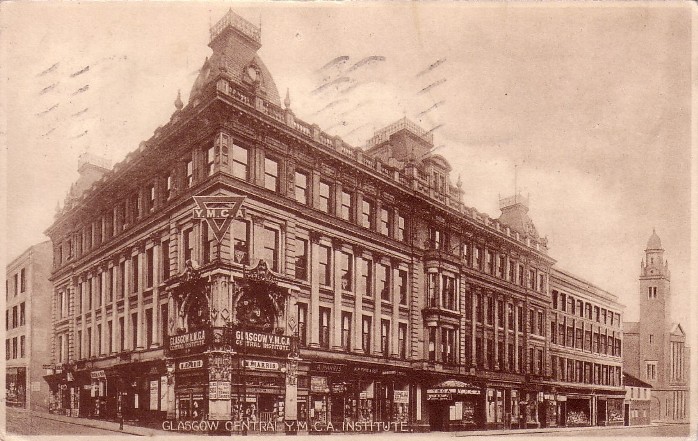
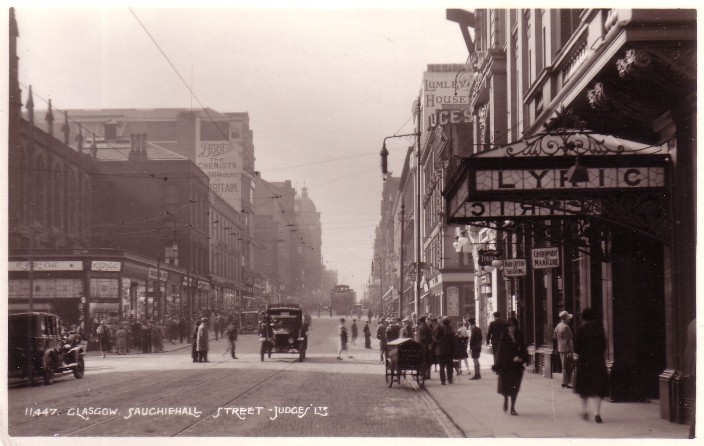
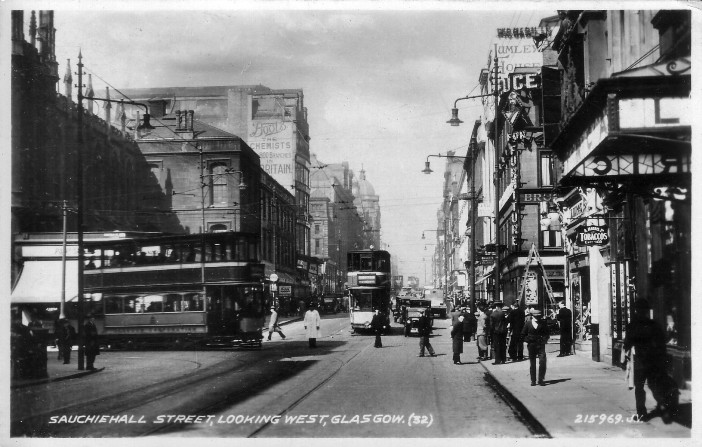
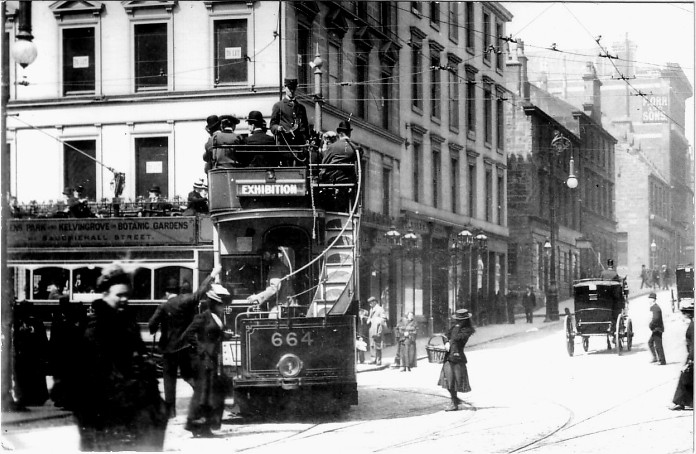
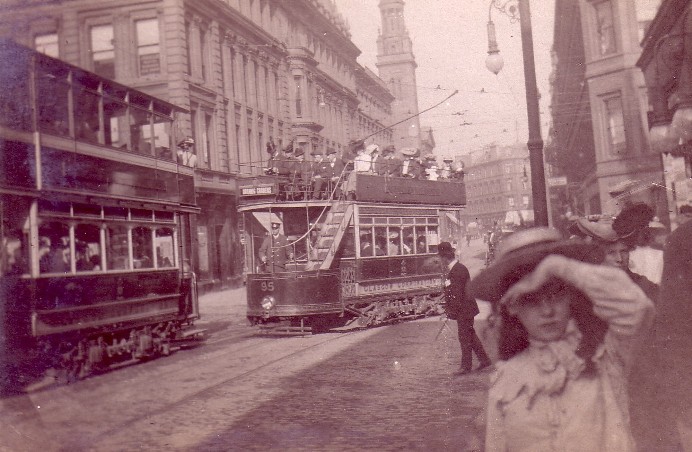
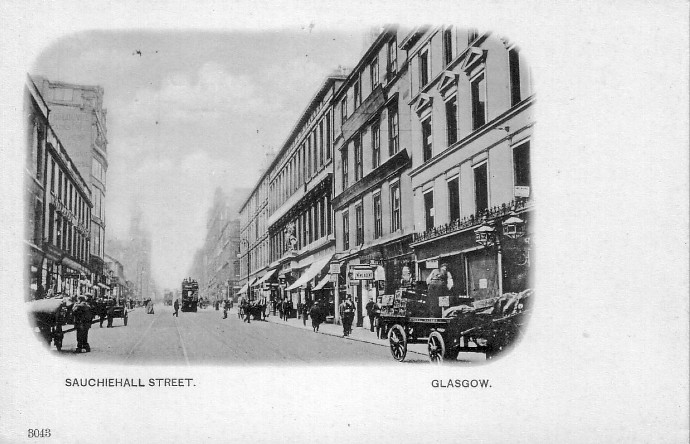
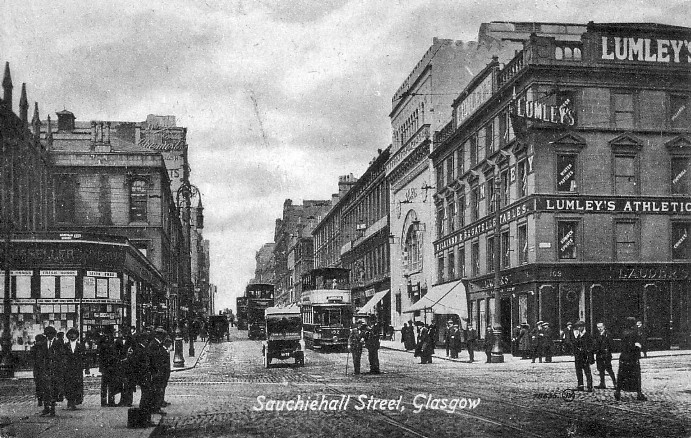
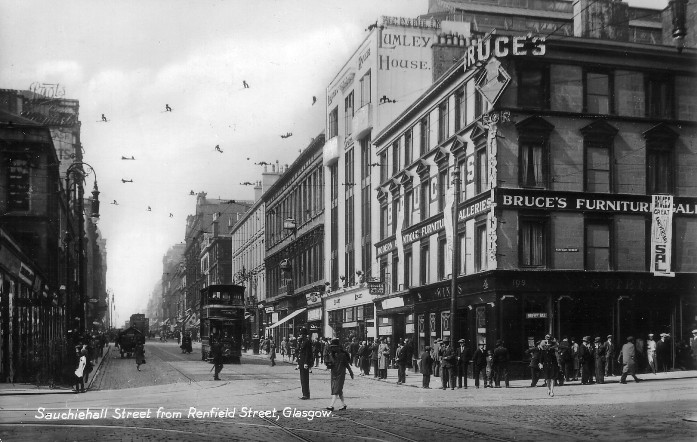
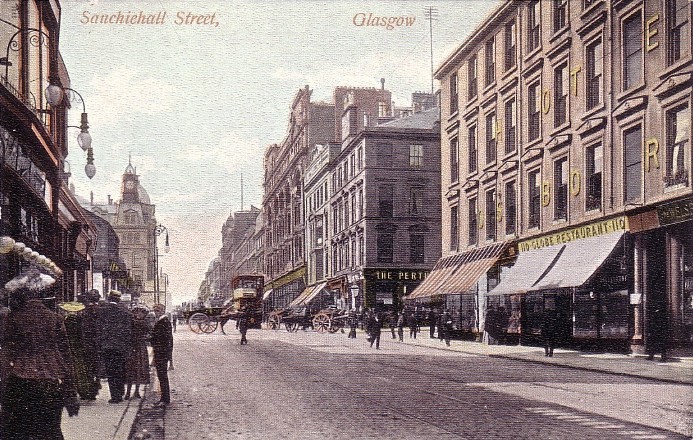
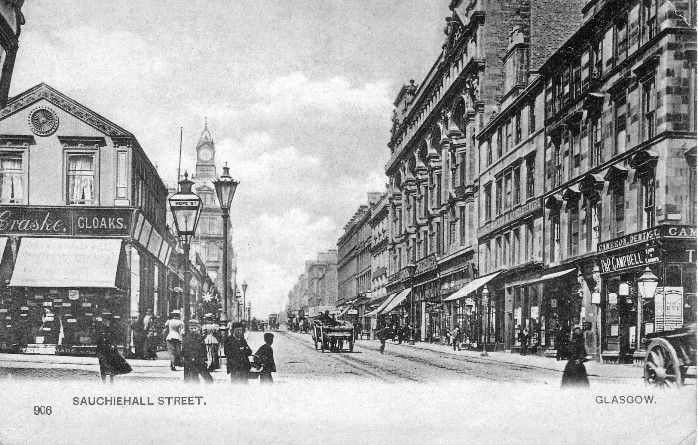
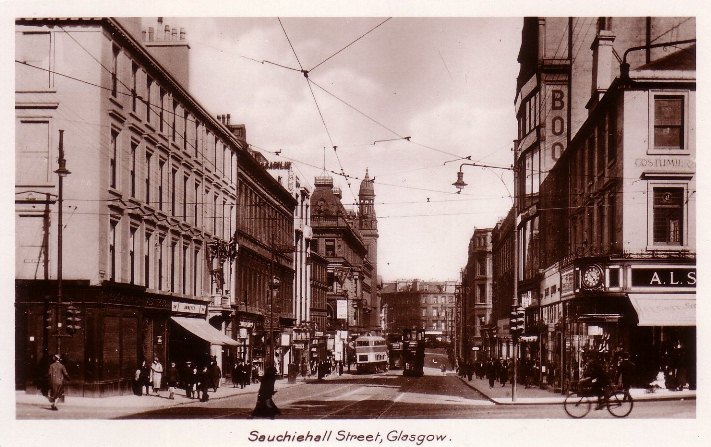
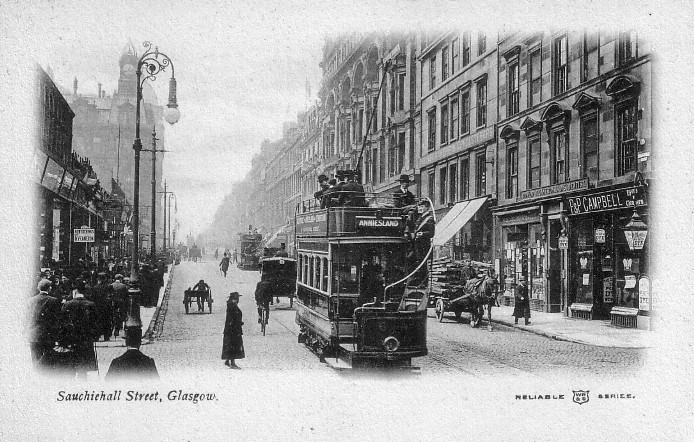
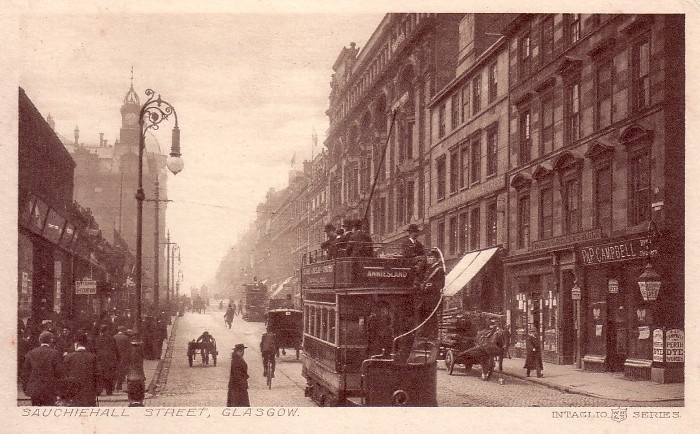
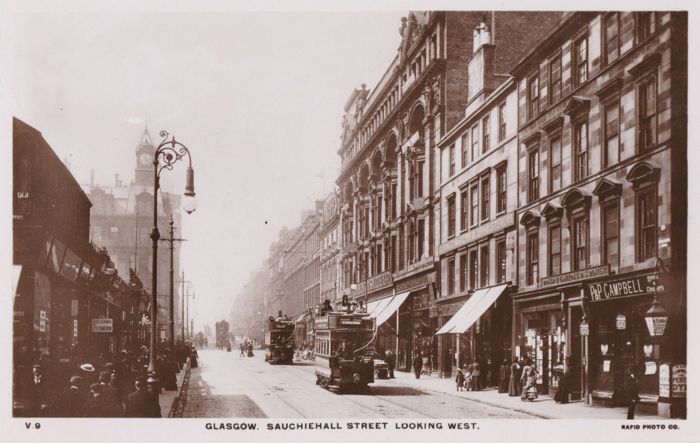
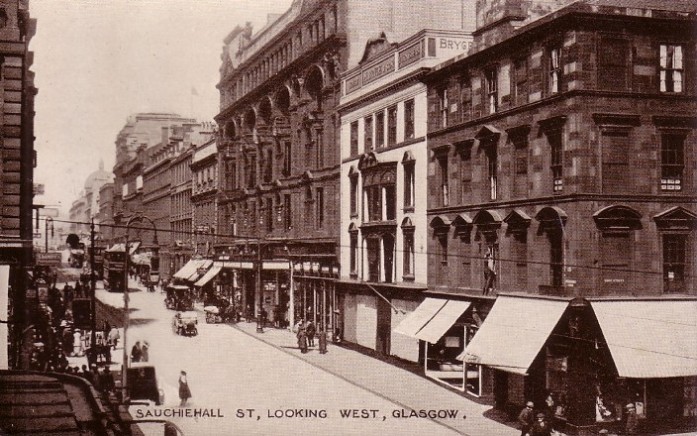
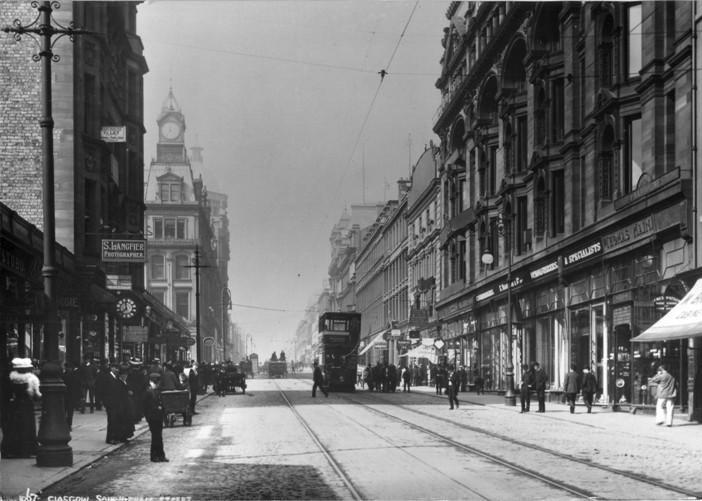
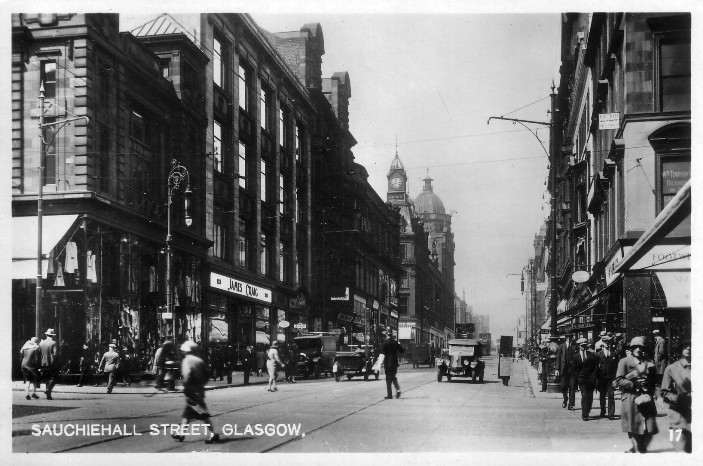
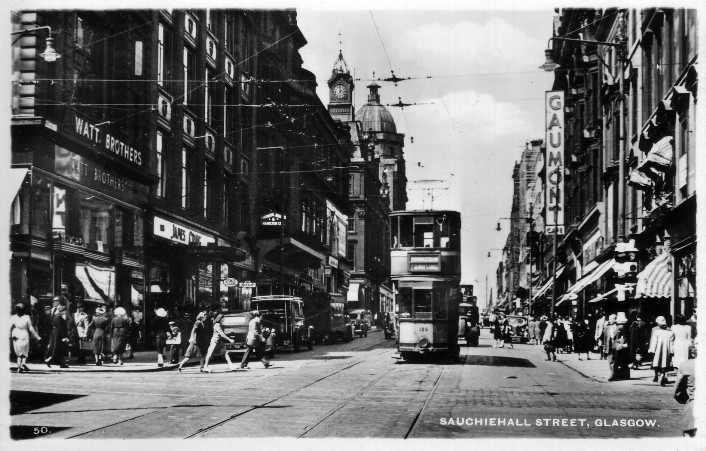
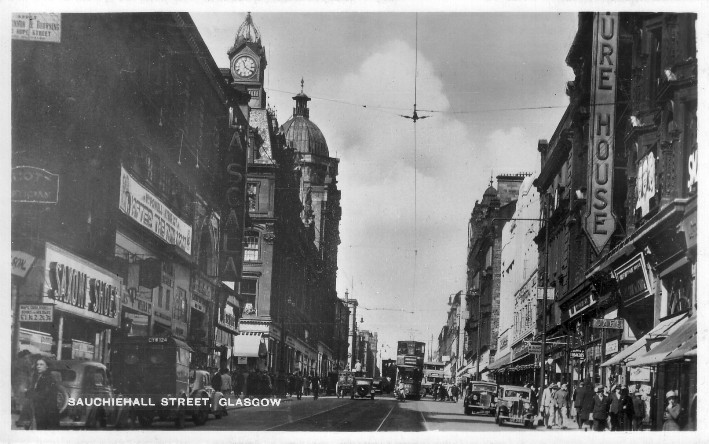
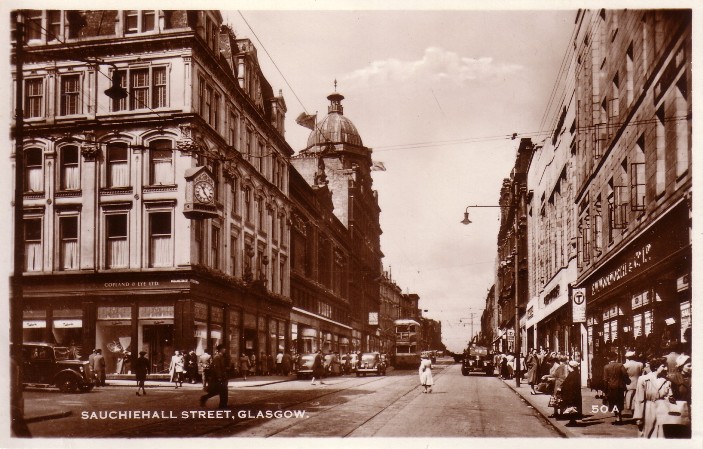
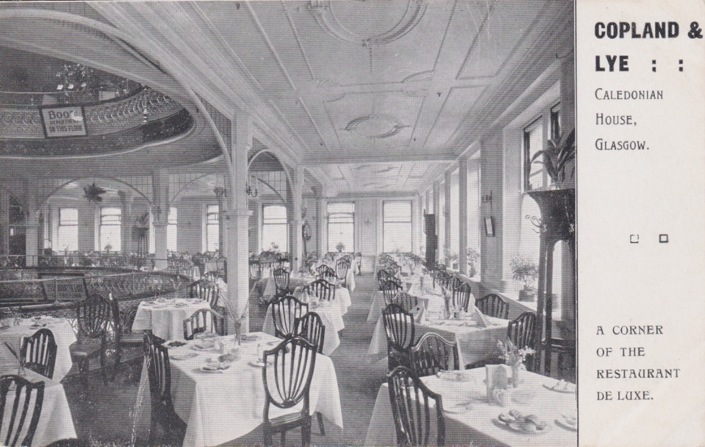
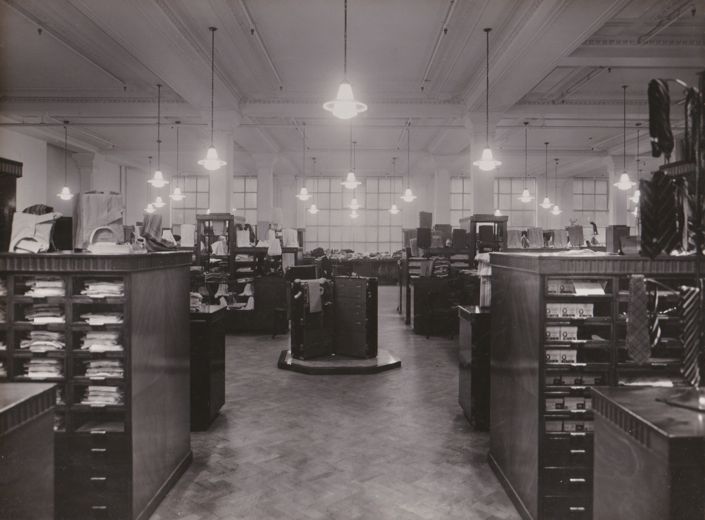
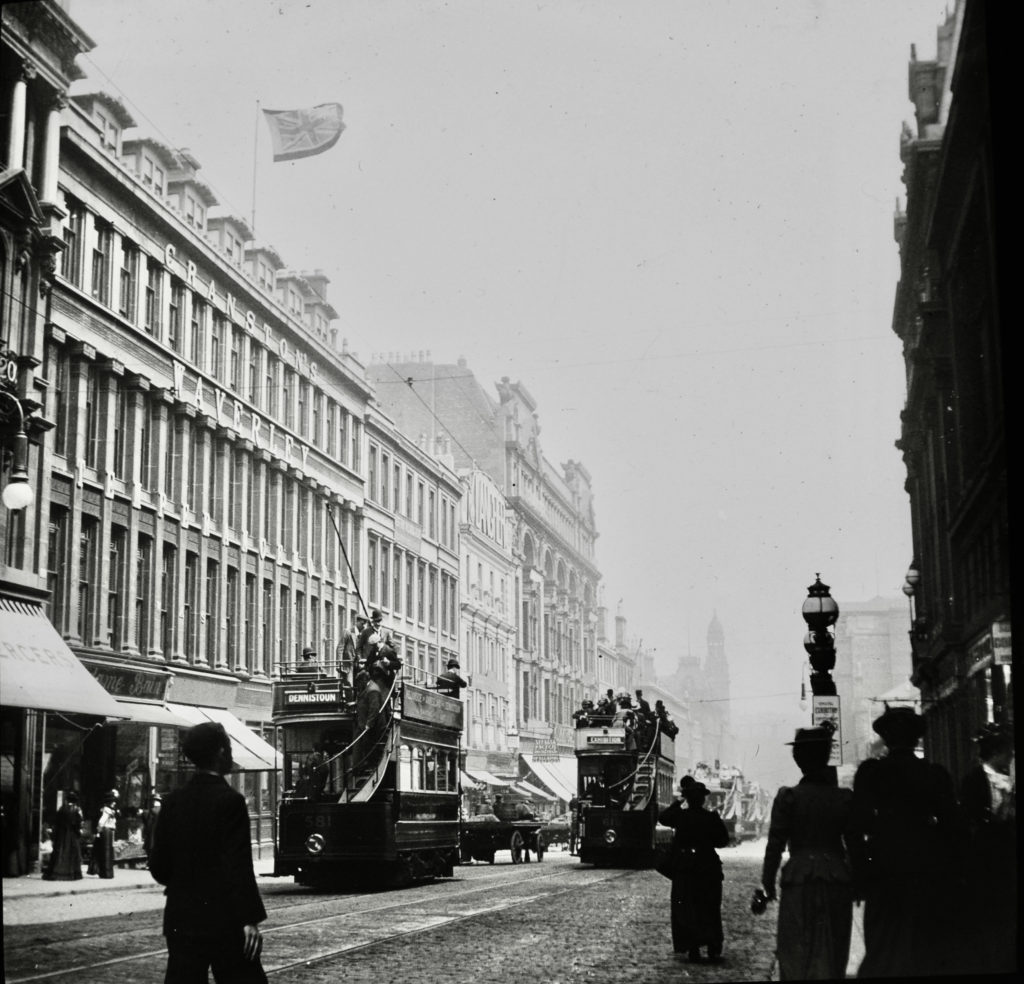
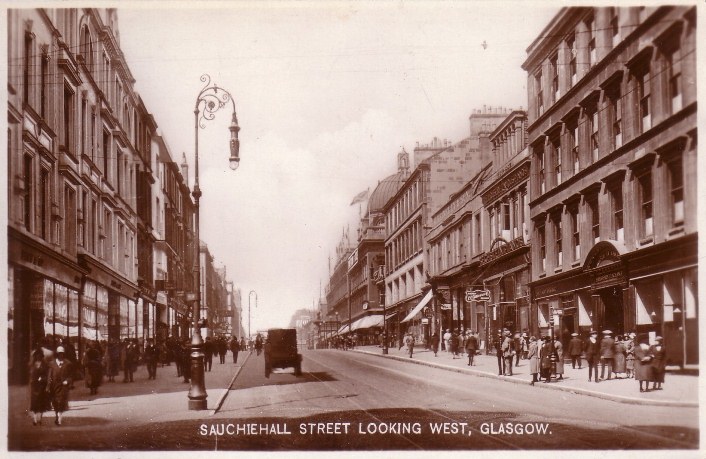
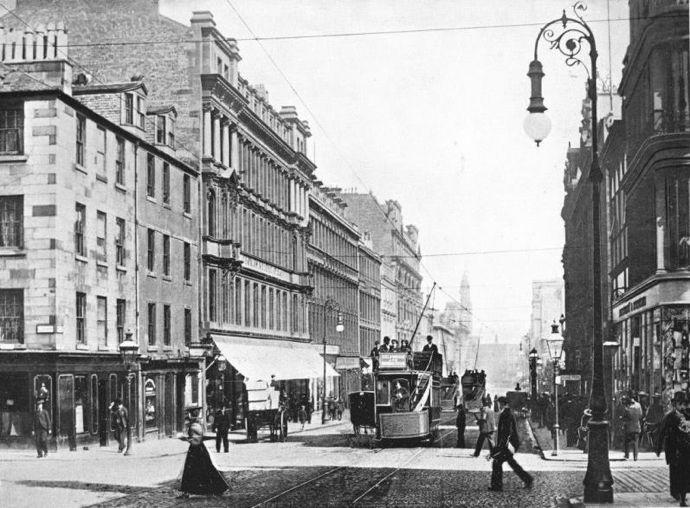
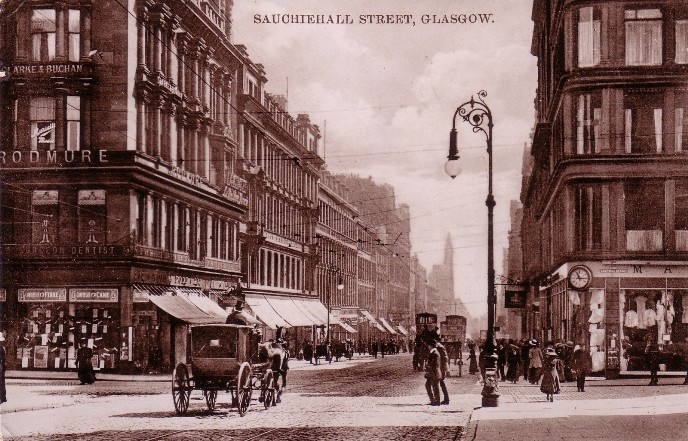
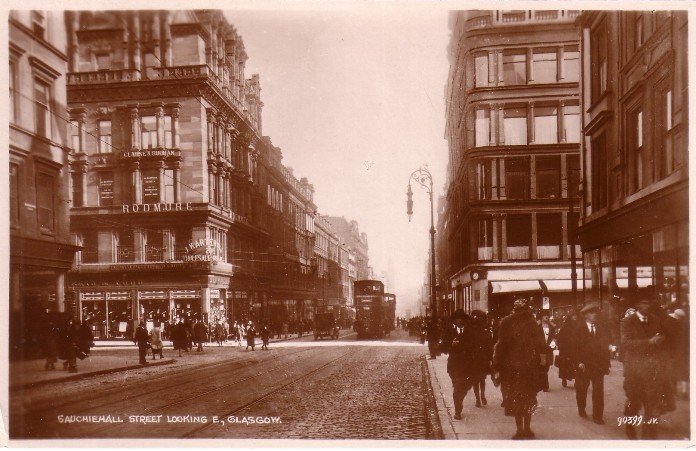
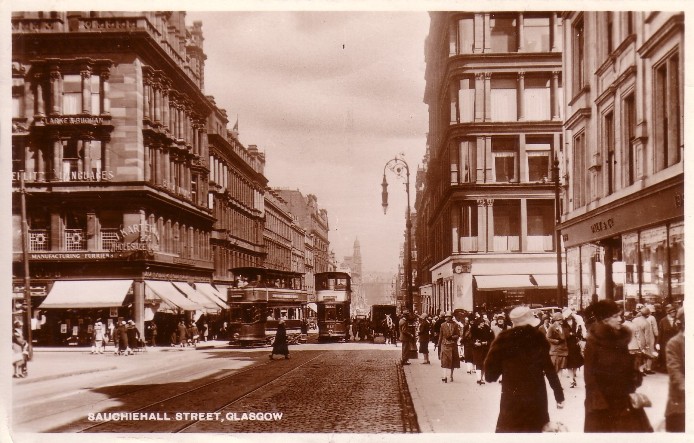
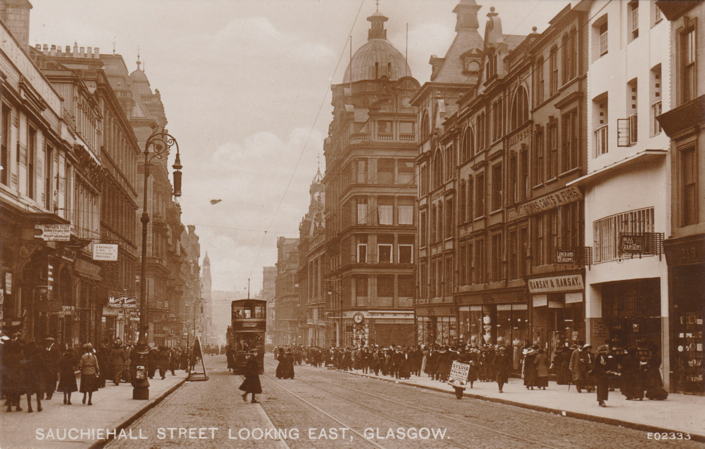
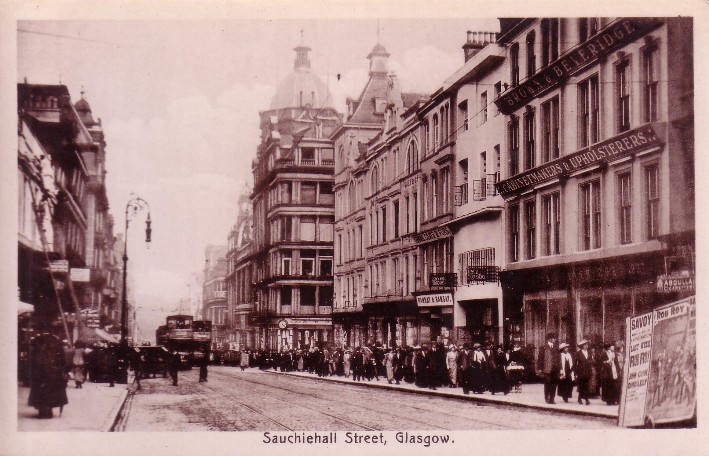
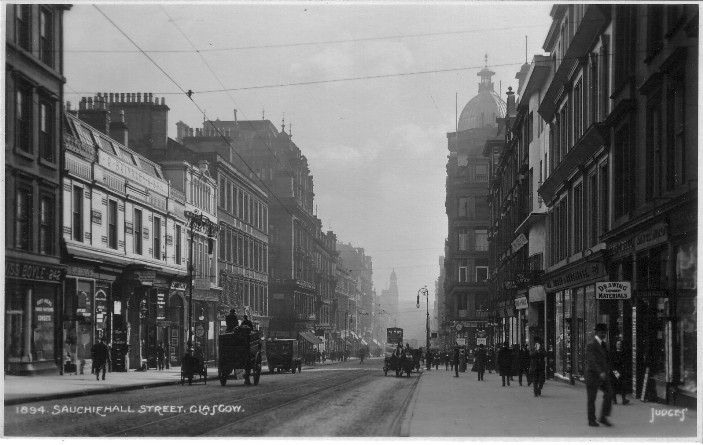
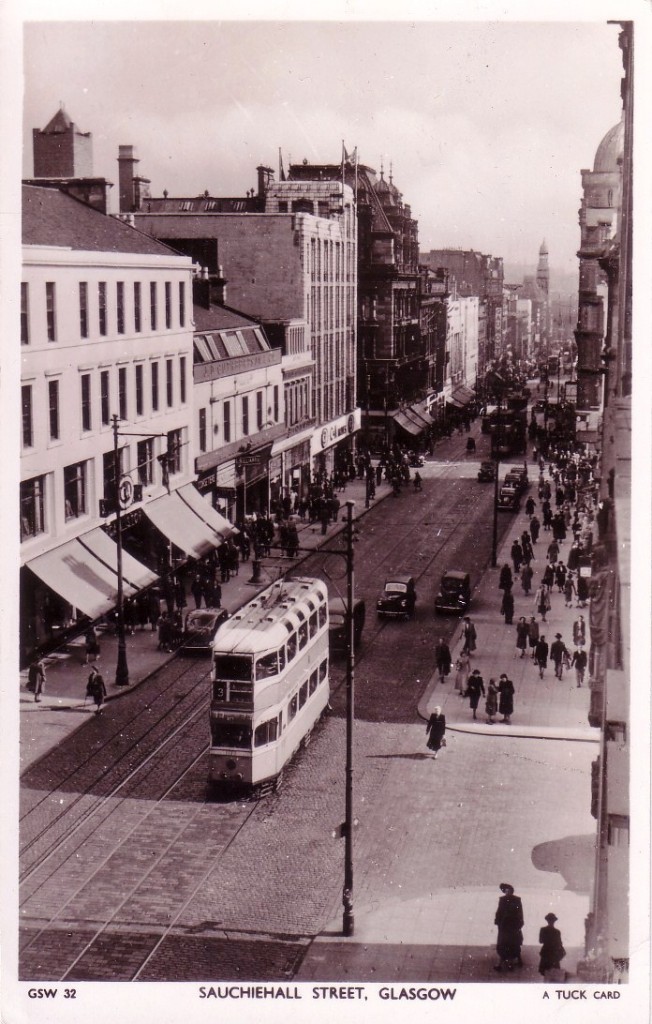
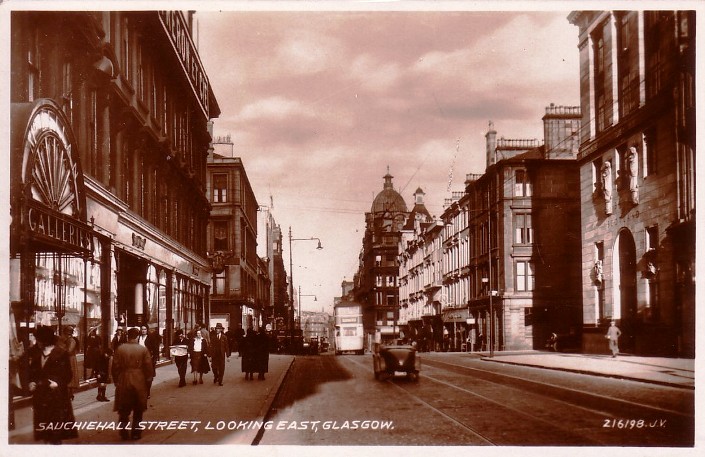
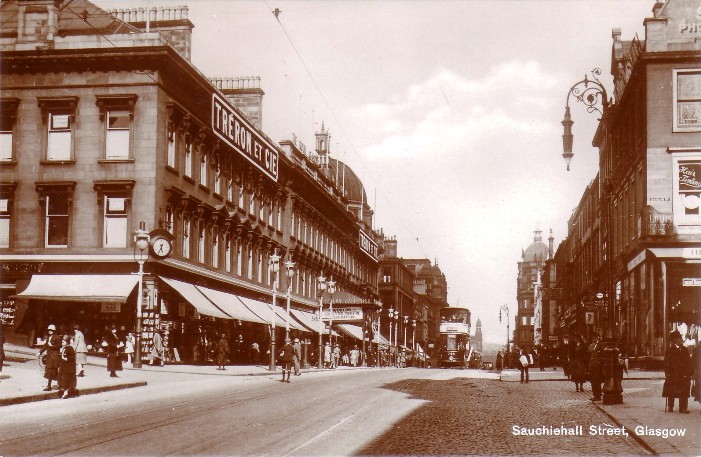
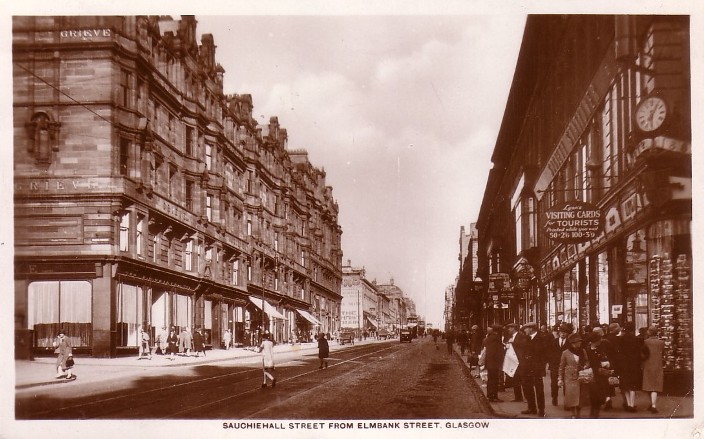
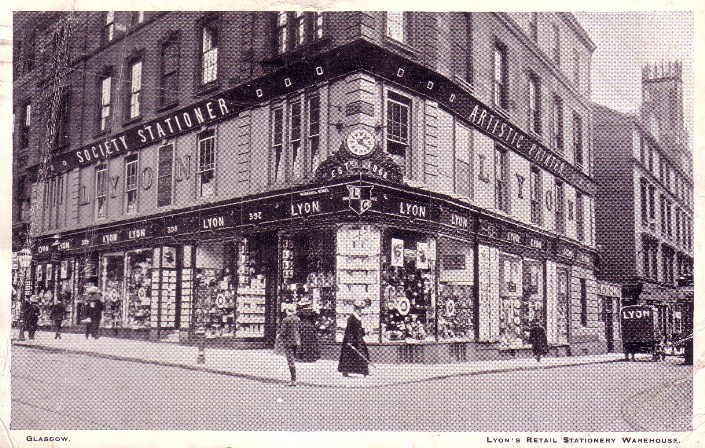
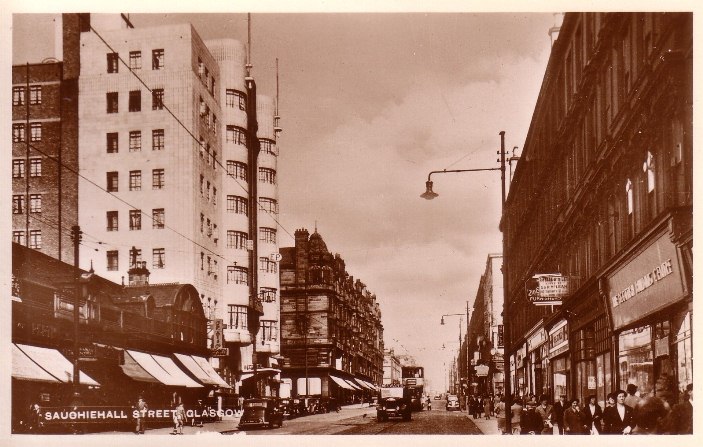
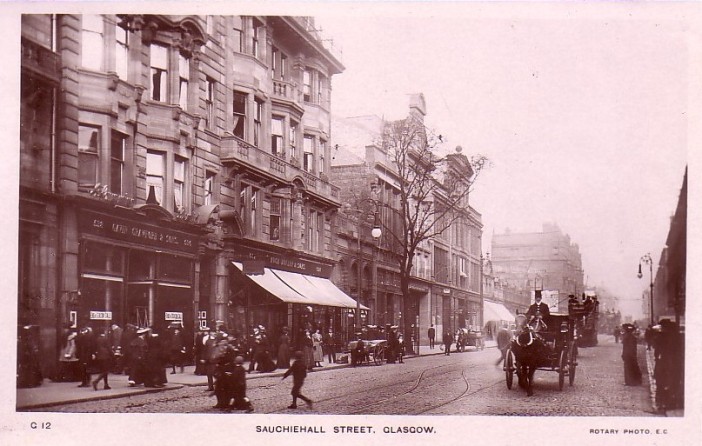
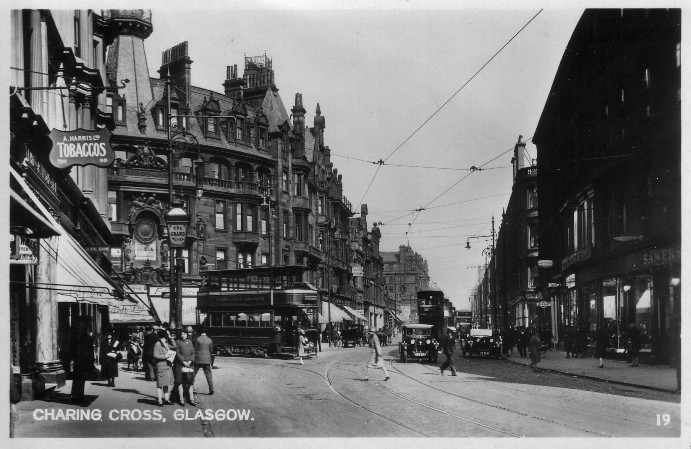
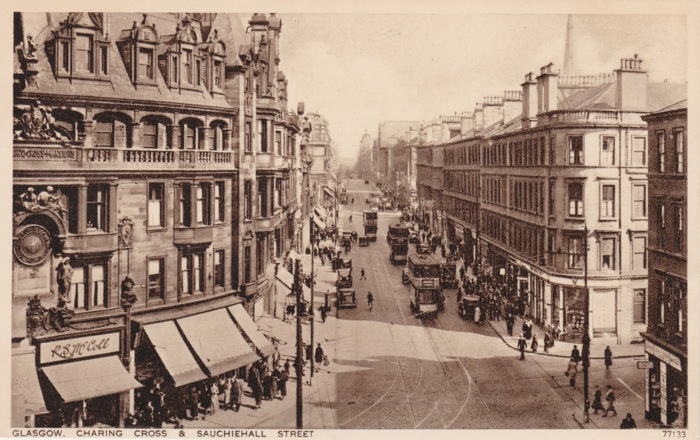

{ 80 comments… read them below or add one }
What a great resource!
A veritable time machine. Any idea what was on the site of the Copeland and Lye building prior to it being there?
Thank you for your comment and question. I don’t know the answer but it’s probably in the city records. I’m checking my early books and have added an introduction to the section on Sauchiehall Street.
Great site, came across it while I was looking up Pettigrew & Stephens as I have some photos of the fire.
Thanks. This website is a work in progress.
Hi, I was wondering if you know anything about 155 Sauchiehall Street. I have been researching my family history, and my great grandparents, John Paterson Montgomery and Anna Veronica McGough were married there in 1926. I believe that today it is a branch of Costa Coffee, but could you tell me any more about this property? Thanks in advance.
Liz
Hello Liz,
Thank you for your enquiry.
According to the 1927 Glasgow Directory which is available online, the La Scala Picture House was at 155 Sauchiehall Street. Here’s the link to the page.
http://freepages.genealogy.rootsweb.ancestry.com/~glasgow/1927address1045.jpg
Are you certain of the date and address where your great grandparents were married?
Hi Chris,
Brilliant work, thanks so much for this site! I’ve just made contact with a cousin of my grandmother’s, neither knew of the other due to a family split over 80 years ago and I’m hoping they’ll be able to meet for the first time in the new year. Very exciting! I have particular interest in this part of Glasgow as I’m looking for info on Skinner’s the bakers, which I believe stood roughly opposite the Grand Hotel. My great great grandfather George Baird was ‘Master Baker’ there circa 1900-1930s and I’d love to find a picture of the premises and any other details if at all possible… Mitchell Library here I come!
Best regards for a lovely Christmas,
Jamie
Hi Jamie,
Thank you very much for your comments about the website. It is a work in progress. I have checked the Glasgow 1927 Directory which is posted online, thanks to the work of Jim Bundy and Andrew Nicoll.
http://freepages.genealogy.rootsweb.ancestry.com/~glasgow/index-glas.htm
You will be pleased to know that there was a William Skinner & Son., baker, purveyor and confectioner at 477 Sauchiehall Street on the south side of the street at the corner with Newton Street. The premises were at the end of the block which ran from Elmbank Street to Newton Street. If you stood the front door of the bakery and looked across the road you would see Albany Place. If you looked left, you would be looking at part of the Charing Cross Mansions, the entry of St. George’s Road and the Grand Hotel. I will check to see if I have any photos including the location of the bakery. William Skinner & Son also had branches at 30 St. Enoch Square and 73 Eglinton Street.
Season’s Greetings to you too!
Chris
I would like to purchase a print of Sauchiehall Street in 1939. Failing that, I would like to purchase a book of prints/history of Sauchiehall St. Can you give me any advice please? Thanks, Joyce
Hi Jamie,
I have managed to find out more about Skinner’s bakery and am adding a photograph showing the location. This photograph is also posted in both the Charing Cross and Sauchiehall Street series in this website. The gap between the buildings on the right hand side of the picture is where Newton Street joins Sauchiehall Street and Skinner’s premises are located on the far corner.
There is a brief reference on page 245 of the book “Glasgow in 1901” by J. H. Muir ( a pseudonym for James Bone, A.H. Charteris and Muirhead Bone ) mentioning “the necessary ladies’ luncheon rooms at Assafrey’s and Skinner’s” on Sauchiehall Street. According to Perilla Kinchin in “Tea and Taste: The Glasgow Tea Rooms 1875-1975”, William Skinner & Son was one of the oldest established in Glasgow, having been founded in 1835. It did not start out at 477 Sauchiehall Street but relocated there in 1875 and subsequently established a reputation for teas and luncheon. The premises were furnished in the French style and cultivated an atmosphere of conservative elegance. The decor was in marked contrast to some of the more avant garde tearooms in the city such as Kate Cranston’s Willow Tea Rooms which had opened in 1903, also on Sauchiehall Street, and whose interior could hardly have been more modern, having been designed by Charles Rennie Mackintosh and his wife Margaret MacDonald. According to Kinchin, “Skinner’s also rivalled James Craig’s tearooms in the matter of the currant bread, shortbread and wedding cakes” so we know what your great great grandfather would have been baking. Latterly, the firm was acquired by John Sword who had done very well when his Midland Bus Services had been merged with S.M.T. He had also built up an airline which at the time was the largest operating in Great Britain. Being the son of an Airdrie bakery family probably explains his interest in acquiring Skinner’s and the company continued in business until 1961.
Thank you for your message Joyce and I have added further information on the history of Sauchiehall Street in the introductory paragraph. When you mention a print, are you referring to a photograph and does it have to be of a particular part of Sauchiehall Street and taken precisely in 1939? Valentine has published photographic postcards that straddle the period. Sauchiehall Street is one of the longest streets in the city and has been well photographed throughout its eastern portion, especially in the section between Renfield Street and Charing Cross. It is not possible to photograph the entire length of Sauchiehall Street from pedestrian level because the street rises to a high point near the Blythswood Street/Rose Street intersection and there is an inflection at Charing Cross. In this website, I’m trying to put together a walk down Sauchiehall Street from the Buchanan Street intersection to just west of Charing Cross, drawing on an archive of photographs, virtually all of which were taken during the first half of the 20th Century. I’m not aware of any publications that go into so much detail on an individual street.
Thanks Chris! What a wonderful insight into great great grandpa Baird’s workplace! I recently made contact with a cousin of my grandmother’s in Milngavie who has told me a little she remembers about her grandad. Apparently he used to tell tales of how he often accidentally dropped a flake or two of tobacco into the Battenberg mixture. Perhaps such “secret ingredients” were a factor in his success!! Right, time for a cuppa and a bun I think…!!
My father worked in Sauchiehall Street, and I knew it very well as a schoolboy between 1946 and 1952. I am amazed how, basically, it stayed much the same from 1900 onwards and I had to look closely to see how the earlier photographs differed from my recollections, so similar are they to my memories of the place. It is really only the styles of motor cars that, in many cases, give the game away. I can let you have quite a lot of additional information if you are interested. But I do have a question for you. I well remember the Ruhl and the several other branches of James Craig’s tearooms in the city. My father used to lunch there, and I often went with him. More memorable than the food was the wonderful and extensive collection of Scottish paintings that adorned the walls – not only of the Ruhl, but of the other tearooms as well. It must have been an important collection, as much for its size as anything else, and I have often wondered what happened to it. Was it auctioned off and, if so, when? It would be fascinating to see an auction catalogue if there is one.
Dear Mr. Liddell,
Thank you for your comment. I agree that much of Sauchiehall Street remained the same during the first half of the 20th Century although the block on the south side of the street between Hope Street and Wellington Street was completely redeveloped and the Beresford Hotel was built on the north side of the street, near Charing Cross.
Most of the information I have on James Craig’s restaurants and tearooms is derived from Perilla Kinchin’s “Tea and Taste, The Glasgow Tea Rooms 1875-1975” published in 1991. James Craig had about 20 branches, the two most prestigious being the Gordon in Gordon Street and the Ruhl in Sauchiehall Street and it was in these two restaurants that much of his art collection was displayed. According to T. J. Honeyman, a distinguished director of the Glasgow Art Galleries, the Craig Collection consisted of “first-rate examples of the work of well-known Scottish artists”. Included in the collection were paintings by D. Y. Cameron, David Gauld, E. A. Hornel, Stuart Park and William Wells, members of the group known as the Glasgow Boys. I don’t know how the paintings were disposed of but they were sold off cheaply when the Gordon closed in 1955 and the Ruhl in 1957. It is possible that Perilla Kinchin may have more information and you may be able to contact her through her publisher, White Cockade Publishing, http://www.whitecockade.co.uk
Jamie, so that explains why Skinner’s was so well patronized. People kept coming back for more cake!
Hi Chris, My partner’s Dad will be 80 at the beginning of March. He lived in Glasgow as a child and has mentioned Sauchiehall Street on many occasions. Would it be possible to get a print of Sauchiehall Street in 1939? Thanks for your help and looking forward to hearing from you. Joyce
Hi Joyce,
I will see if I can find a sharp photograph of Sauchiehall Street from around that time period and send you a high resolution scan. There would be no charge. You might also want to check the Annan Photographs website http://www.annanphotographs.co.uk/glasgowstreets3.html because they have a photograph taken in 1938 that features part of Charing Cross with a view up Sauchiehall Street . There doesn’t appear to be a section devoted to Sauchiehall Street on their website but you could consider the Charing Cross photo, numbered OG 57. It should be possible to order a print to suit your specifications. Chris
Do you know if there are any pictures of Karter Furs?
I believe it was opposite either Trerons or C&A.
My sister worked there in the forties.
Thank you,
Joan
Dear Joan,
Thank you for your enquiry. J. Karter & Co., Manufacturing and Wholesale Furrier, was located at 206 Sauchiehall Street, on the north side of the street near the junction with Cambridge Street and across from Pettigrew & Stephens. I’m including two photographs showing the location of the company and the signage on the corner of the building on the left, above Reid & Todd’s frontage. The first view dates from 1923 and the subsequent photograph was taken a few years later. Both of these photographs are also featured in the series above on Sauchiehall Street.
Thank you so much. Although I have lived in the U.S for sixty years I still recall taking my first pay envelope across the street to C&A to buy a blouse.
I don’t know what C&A stood for– we used to say ” civility & attention”, or better yet ” coats & ‘ats. I doubt if even Google would be able to help.
Thanks again,
Joan
You’re welcome Joan. Google is able to help and a quick check has revealed that the name C&A was derived from the first name initials of the brothers Clemens and August Brenninkmeijer who founded the company in 1841 as a Dutch textile business. You can read more about it at http://en.wikipedia.org/wiki/C%26A The company is still in business in many countries but they withdrew from the United Kingdom in 2001. C&A, labelled as the Bargain Store, used to be located on the north side of Sauchiehall Street in the block between Cambridge Street and Rose Street.
Hello Chris,
I found your lovely website whilst searching for some info and wondered if you could help me?
I have a beautiful vintage dress in my collection, on which the tag reads ‘Kings of Sauchiehall Street, Glasgow’. I wonder do you know anything about this shop? The dress looks to be from the 40’s-50’s and I can’t seem to find anything about the shop/dressmakers it came from!
Thank you so much in advance,
Katie
This is a message to Joan Fletcher, could it please be passed to her.
Joan,
You say your sister worked for Karter Furs during the 40’s. I am doing family history research on this firm because my cousin Frank Wilson married one Stella Karter in 1956. It’s him or his descendants I’m really trying to trace. I know I’m on the right trail because on their marriage certificate her father is listed Robert Karter, Trapper! Any information on Stella or the family would be very welcome.
Many thanks in advance
Regards,
Paul
Hi Chris,
Great site! It’s really good that dedicated people like yourself put in the time to inform and save important information like this. My question is relating to James Craig: I have a table marked James Craig & Co., 498, Sauchiehall Street. House furnishers & Artistic Decorators. Would this be the same James Craig who owned the tearooms? If so, do you know when the furnishing branch operated?
Thanks. Steve.
What a great website! I was researching an old set of clothes brushes in a leather case that I found in my attic and ended up here.
Actually, would you be able to help? The brushes were made by Reid and Todd, and I noticed that this post tags ‘Reid and Todd’ but you don’t mention it in the main article. Do you know anything about Reid and Todd?
Many thanks, and great work!
Hello Annie,
Thank you for your comments and question. It’s interesting that you mention having a leather case for your clothes brushes because Reid & Todd had a reputation for selling fine leather goods, including handbags and suitcases. I’m thinking that your leather case would carry their mark.
They were listed in Kelly’s 1880 Directory of the Leather Trades as portmanteau manufacturers located at 50, 52, and 54 Glassford Street. In 1901, they had branches at 6/8 Renfield Street, 56 Gordon Street and 56 Glassford Street, selling fine leather goods, travelling requisites and umbrellas. They subsequently moved from the Gordon Street and Glassford Street premises to 212 Sauchiehall Street on the corner with Cambridge Street, as shown in the photographs.
Hi Steve,
Thank you for your enquiry. James Craig who owned the tearooms had premises at 123 Sauchiehall Street, on the south side of the street next to Watt Brothers, in the block between Hope Street and Wellington Street. There was also a bakery at 451/3 Sauchiehall Street, on the south side of the street, in the block between Elmbank Street and Newton Street. The person who operated the furnishing and decorating business was a different James Craig and his premises at 498 Sauchiehall Street were on the north side of the street between Albany Chambers and Thistle Street, near the Locarno. He was certainly in business at the time of the 1927 Glasgow Directory.
Hello Katie,
Thank you for your question. I believe there is a Kings Clothing located in the Savoy Centre at 140 Sauchiehall Street. I’m not aware of an earlier shop or manufacturer by the name of Kings of Sauchiehall Street.
Hi, I’m doing some family history research and came across your web site. Thanks for your hard work! My mother and her family grew up in West Nile Street. She was born in 1942 and lived there until her mother died from TB when she was 12. Her father had joined the First World War and at 17 had his hip blown off. He had worked as a riveter in the Glasgow shipyards but by the time he married late in life and had children, he was a newspaper seller. Do you have any information or pictures of West Nile Street, or can you point me in the right direction? Thanks in advance.
Hi Alan,
Thank you for your comment and for sharing the details of your family history. Are you familiar with Glasgow? Your mother was raised very close to the city centre. I’m wondering if you have an address for the location. West Nile Street runs from Cowcaddens down to Gordon Street and then becomes Mitchell Street. During your mother’s time there, the trams (service nos. 11, 13 and 23) travelled along much of the length of the street and latterly tram service 13 was replaced by trolleybus service 105. I don’t have any photos and have yet to find a postcard or albumen of the street. I have been searching but they are obviously very rare. You could try contacting the staff of the Glasgow Room at the Mitchell Library. They will probably have some material on file. Do you know in which shipyard(s) your maternal grandfather worked as a riveter?
I will certainly be in touch if I come across any material.
Hi
What a fascinating insight into Edwardian Glasgow. I was wondering if you knew anything of J. Sanderson at 305 Sauchiehall St., a ladies clothing store, not sure when they started up. I have acquired a baby’s silk embroidered dress with a label stitched in referring to the shop.
Hi Chris,
What a wonderful website; the quality of the images is excellent!
Where did you come across the image published by Schwerdtfeger showing the Willow Tea Rooms and Pettigrew & Stephens Manchester House?
I’d be grateful for information. I’m one of the researchers on the Mackintosh Architecture project at the University of Glasgow and that image would be a great addition to the our image set for both buildings.
Thanks in advance! :o)
Thank you for your enquiry. I can confirm that there was a John Sanderson Ladies’ Outfitter at 305 Sauchiehall Street, listed in the Glasgow 1927 Directory. The business was located on the south side of Sauchiehall Street at the corner with Pitt Street.
A note published in the Edinburgh Gazette of May 13, 1932 reported that the estates of Mrs. Christina Sanderson, widow, who was conducting business as a ladies’ outfitter under the name John Sanderson, had been sequestered. http://www.edinburgh-gazette.co.uk/issues/14860/pages/394/page.pdf . This was to enforce the payment of debts and a subsequent notice in the Edinburgh Gazette of April 23, 1933 indicated that those debts were being repaid. http://www.edinburgh-gazette.co.uk/issues/14959/pages/346/page.pdf . I don’t know when the business closed.
Hi Nicky,
Thank you and I’m glad you like the images. I obtained the version of the E. A. Schwerdtfeger postcard on eBay. Examples of it come up from time to time and there was one on eBay recently. The depth of field on Schwerdtfeger postcards is extremely good and I consider them to be the finest Glasgow postcards of the period for clarity and composition. Some of the scenes are quite exceptional. The postcards were printed in Berlin and when the Great War broke out, all things German were scorned and so any traces of the name and German printing were removed. The images were reissued anonymously, as in the case of this one, and new ones added later, during the 1920’s. I would be happy to send you a high resolution scan of the postcard for your project if you wish.
Hi Chris,
Thank you for your reply. I would very much like to take up your offer of a high-res scan of the postcard. Would you be happy for us to use it on our website? Due acknowledgement would be given to you, of course.
Look forward to hearing from you.
Hi Nicky,
Consider it done and you’re welcome to use the photograph on your website. I will send the scan to your email address.
Hi Chris,
Fantastic! Thanks so much! In your email, would you let me know how you’d like your name to appear in the credit line with any official title etc.
Also, if you have any further info on Schwerdtfeger, I’d be grateful, just in case we have to seek copyright permission.
Many thanks!
Hi Nicky,
I have since responded to your message via email and sent the scans.
Wishing you the best of success with your project.
Chris
My grandparents got married at 350 Sauchiehall Street in 1932. Is that an address of a church?
Hi,
Can you let me know if any of the Sauchiehall Street pictures are available for reproduction please.
Kind Regards,
Ken Mellin, Glasgow
Hi Karen,
Thank you for your enquiry. At the time your grandparents got married, 350 Sauchiehall Street was the location for the Prince of Wales Halls in the Grecian Buildings, also known as the Grecian Chambers, which extend westward from Scott Street. Designed by the celebrated Glasgow architect Alexander (Greek) Thomson, the exterior of these fine buildings has been preserved and number 350 is currently part of the Centre for Contemporary Arts.
Hi Ken,
Thank you for your enquiry. Can you let me know which photos you have in mind?
Kind regards,
Chris
Hi Chris
Just a note to say well done. Your website is excellent and your knowledge and enthusiasm shine through. Your hard work is also evident.
Well done.
Thanks Stewie. This website is a tribute to Glasgow, its people and their achievements.
Hi Chris,
Does anyone know when the retail and wholesale furriers J Karter & Co. went out of business? They are shown in two of the photographs, on the corner of Sauchiehall Street and Cambridge St, in the Reid and Todd building.
Jane
Absolutely fantastic !!!…… Having recently visited, I appreciate the pics and the history alongside the pics. Cheers.
Hello,
I’m sending you this email on behalf of my 89 year old mother-in-law Mrs Catherine Mullen (nee Bradley) who was born in Glasgow and now lives with us just outside Bristol.
We came across your wonderful website when looking for a shop called Lumleys! Going through your photos reminded her of being a small girl growing up in Glasgow and she has been coming out with some interesting memories! If you are interested, I will jot them down and pass them on to you if you so wish.
Kindest regards,
John
Thank you John for your message and I’m glad that the photos brought pleasure to your mother-in-law and reminded her of her childhood in Glasgow. I would certainly be interested in knowing more and will be in contact with you via email.
Best wishes,
Chris
Hi Chris,
I’ve was searching for information about Karter furs, when I came upon your superb website, which incidentally was about the only reference I could find. Strange to think that what was once almost an iconic institution could be so easily forgotten. I wondered if you had any information as to when Karter vacated their Sauchiehall Street premises, and what became of them? Did they move or close at the onset of furs becoming unfashionable? Any information would be really appreciated.
Kind Regards
Lynne
Hi Lynne,
Thank you for your question and I will see what I can find out for you. Others are welcome to write in.
Best wishes,
Chris
Hello.
My father-in-law is 80 on 23rd February and I’ve decided to try and find something “memorable” for him. He was born in 1932 and there are a few prints of Sauchiehall Street that are from that year, one actually has ’32 on the print. Would you be able to email me these scanned images please? I see you have indicated that this is something you can offer. I can then have the images enlarged and framed or put on a canvas. If you have any other famous Glasgow images from 1932, I am open to looking at these too. As you see, I’m running short of time. Nothing like being organised! Great website!
Thanks, Tracy
Hello Tracy,
Thank you for your enquiry and we have since corresponded via email and I have sent scans of scenes from 1932. I have now identified two more and will send them shortly.
Best wishes,
Chris
Hello there,
Fantastic website! I love looking at old photos, especially photos I can relate to! Excellent work!
Do you have any old photos of Knightswood? I was brought up there and would love to see what it used to look like.
Many thanks,
Scott
Hi Scott,
Thank you for your comments. I do not have any old photos of Knightswood but if I come across any I will let you know.
Best wishes,
Chris
Your article is fabulous.
I found it because I have an old sepia tone, nicely framed photo that I bought years ago, and recently opened up. Inside the brown paper backing there is a label that reads : From Andrew Duthie, fine art dealer, picture frame maker, 426 Sauchiehall St. The rest is missing, unfortunately.
But looking at the materials in the frame and framing, I suspect the photo was framed there in Glasgow. I would love to know when Andrew Duthie was in business there, if you can find out.
Thanks so much!
Deborah
Hello Deborah,
Thank you for your comment. I have checked the 1927 Glasgow Directory which is available online and Andrew Duthie was still in business at that time. The entry states “fine art dealer and picture-frame maker, 426, 428 Sauchiehall Street ( Established 1867 ). There is also a residential entry for a Geo. A. Duthie ( of Andrew Duthie, 426 Sauchiehall St. ) who was presumably continuing the family business.
Best wishes,
Chris
I was born at 277 Crown Street in 1922 and have many memories of being marched round the shops as a child with my mother. I got to know the city pretty well.
In 1928 we moved out to Knightswood which was then just under construction. Abbotsford was my first school, then Cloberhill after we moved.
Jim
Hello Jim,
Thank you for your message and congratulations on reaching 90. You must have many memories of the city and what is was like to live there during the 1930’s and then in the war years. You would have been there at the time the great liners, Queen Mary and Queen Elizabeth, were launched and I’m sure you recall when all the ships sirens would sound in the New Year.
Wishing you many more years.
Chris
Thank you for all the old pics. I really enjoyed looking at them. I was living in Garnet Hill in the 40’s up until 1962.
Ruby
My siblings and I went to Garnet Hill School and I spent many a lunch break roaming up and down Sauchiehall Street, Kelvingrove Park and the Art Gallery. Great memories from the 50’s. Thanks.
Ruby
Thank you for your comments Ruby. I’m glad you can relate to the photos.
Regards, Chris
These photos are great! I’m not sure if you are able to help. I’m trying to track down a photo of my grandfather’s health food shop which was on Sauchiehall Street in the 1940’s. I believe health food shops were very few and far between back then! Even the name of the shop if anyone can remember would be great!
Thanks,
Helen
Thank you Helen. Can you provide any further information, for example, your Grandfather’s name and details about the location such as number, nearest cross street or closeness to any other business or major building so that I can focus in on the location and see what I can find? Many of the smaller businesses were located west of the large department stores and closer to Charing Cross.
Regards, Chris
A wonderful history of a prime Glasgow Street. Did you come across Piercy and Lawson, outfitters and tailors for gentlemen, in existence from the 30s to the early 60s? It was owned by my grandfather Harold Piercy …. Any information gratefully received …
Hilary
Hi Chris,
On 25/02/12 you emailed pictures to Tracy Brown of photographs from 1932. Would you be able to send me a copy of these as my grandfather is turning 80 next month and I am trying to present him with a collage of photos from then and now?
Thank you very much.
Alana
Thank you Hilary. So far, I have not come across the business of Piercy & Lawson. I only have access to the 1927 Glasgow Directory where they are not listed, which is not surprising considering that it is prior to the time you quote. Do you have an address for their business or access to a directory for a later date? Once we have an address, I will see if I have any photos of the location at the time they would have been in business.
Best wishes,
Chris
Hello Chris,
Stumbled upon your site by chance and have so enjoyed seeing these photographs. I was born in Rose Street and know Sauchiehall Street and its surroundings so well. Thank you for these great images and the memories they invoke.
Alex
Hello Alex,
Thank you for your comment and for sharing this information. Rose Street continues continues as Blythswood Street on the other side of the intersection with Sauchiehall Street and you may know that Blythswood Street was previously called Mains Street.
Best wishes,
Chris
Hello Alana,
Thank you for your request and I am happy to oblige. I have emailed the photos to you.
Happy 80th birthday to your grandfather.
Chris
Hello Chris,
I just wanted to say how much I enjoyed your photos of Sauchiehall Street. I was just there last Sunday taking some photos of the lovely buildings and trying to remember what the buildings were originally. I was trying to remember the name of the umbrella, bags and luggage shop at the corner of Cambridge Street and Sauchiehall Street and then I saw it: Reid & Todd of course. Thanks.
Do you know the building in St. Vincent Street which is now empty? It has two clocks side by side and I once read that it was occupied by a newspaper publisher. I can’t find anything on it and it is such a beautiful piece of architecture.
We are very lucky here in our old and beautiful city to have so many fantastic buildings. Thanks for your site. It’s really interesting.
Cecilia
Hello Cecilia,
Thank you very much for your comments and for appreciating Glasgow’s architectural richness. The city has certainly been blessed by some very fine architects. I am not in Glasgow at the present time but if you could give me the address of the building in St. Vincent Street, I will look into it for you.
Best wishes,
Chris
Hi Chris,
What a lovely website! I really enjoyed looking through the old pictures.
I came across this while looking for some information on Archibald Stewart & Co, who I believe furnished ships. So far, I’ve found an old address for them on Argyle Street however the piece of furniture which I purchased (and the whole reason this fact-finding-shennanigan started!) has the address 265 Sauchiehall Street on the brass plate inside.
Do you, Chris, or does anybody else who has commented know where I might find a bit more information on this company? I’d like to know where my wardrobe came from! 🙂
Thanks!
Laura
Hi Laura,
Thank you for your kind comment and question. I have checked the two Glasgow Directories that I have on file, namely those for 1902-1903 and 1927, and the findings were as follows:
Glasgow Directory 1902/1903
Stewart, Archd., & Co., cabinetmakers and upholsterers and carpet warehousemen, 42 to 48 Union Street; works, 40 Union Street.
Glasgow Directory 1927
Stewart, Archibald & Co., cabinetmakers, upholsterers, carpet factors, decorators, specialists in artistic furnishing fabrics, 42 to 48 Union Street; works, 40 Union Street.
Archibald Stewart lived at 31 Sutherland Avenue, Maxwell Park.
In the 1927 Directory, the address at 265 Sauchiehall Street was occupied by a branch of James Munn & Co. Ltd., the confectioners, fruiterers and tea merchants.
It would be worth checking more recent Glasgow Directories, probably held at the Mitchell Library. Do you know the approxiate date when your wardrobe was made?
Best wishes,
Chris
Hi Chris,
I have an old picture showing a lady, a milkmaid and two gentlemen, by artist Pieter de Hooch and framed by David Campbell Brown of Sauchiehall Street. Can you give me any information about the artist and the framer?
Thanks.
Thank you for your inquiry and I have some information for you.
According to Wikipedia, the artist Pieter de Hooch ( 1629-1684 ) was a genre painter who lived during the Dutch Golden Age. He was a contemporary of Dutch Master, Jan Vermeer. http://en.wikipedia.org/wiki/Pieter_de_Hooch You can view images of Pieter de Hooch’s work.
The 1927 Glasgow Directory is available online and David Campbell Brown is listed as a fine art dealer, gilder and picture frame maker, located at 482 Sauchiehall Street. His home address was 49 Randolph Road, Broomhill. I have no further information but I hope this helps. If your work is an original painting, you might want to consult an auctioneer and valuer.
I just enjoyed an hour of nostalgia looking at your photos. I worked at J. Karter, Furriers on the corner of Douglas Street in 1967/68. I remember Copeland & Lye and Pettigrew & Stephens. Happy days..
Hi Chris,
I saw the comment from Hilary Napier about Piercy & Lawson when I Googled them and hope you could pass on my email address to her. I have a gent’s dress stud set that was made by them and would like to send her some pictures.
Thanks,
Kirsty
Thank you Kirsty and as you can see I have posted your comment. I will also pass on your email address to Hilary. Is a postal address for Piercy & Lawson supplied with your gent’s stud set?
Thanks,
Chris
I think that the parade at the end might have been filmed in North Woodside Road. The tenements have gone but the terraced houses are still there behind Lansdowne Crescent.
Sandy